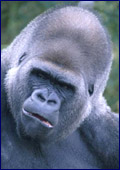Great Ape Profiles
Updated February 21, 2017 | Factmonster Staff 

Great Ape Profiles
| by Holly Hartman |
| Gorilla (Gorilla gorilla) The largest Great Ape |
 Males: 400 pounds (180 kg); up to 6 feet (1.8 m) standing Females: 200 pounds (90 kg); up to 5 feet (1.5 m) standing Habitat: Lowland gorillas live in rainforests in East and West Africa; mountain gorillas live in rainforests in the Democratic Republic of the Congo, Rwanda, and Uganda. Community: Up to 30 gorillas live in a troop. A troop includes one male, many females, and their offspring. Diet: Plants and some insects. Wild gorillas have big potbellies, which are full of bulky plants. You'll notice: The silvery back of the adult male Baby fact: Baby gorillas have little white tufts of hair on their bottoms that look like tails. |
Did you know? An adult male gorilla is very protective of his family. He will stand and beat his chest to scare away intruders. This is where the idea of King Kong comes from. But the truth is that gorillas generally have quiet, peaceful lives. |
| Orangutan (Pongo pygmaeus, Pongo abelii) The world's largest arboreal (tree-dwelling) animal |
 Males: 200 pounds (90 kg); up to 4.5 feet (1.4 m) standing Females: 110 pounds (50 kg); up to 3.5 feet (1.1 m) standing Habitat: Tropical rainforests in Borneo and Sumatra Community: Orangutans are more solitary than other great apes, though mothers and their young stay close for years. An orangutan eats a lot of fruit, and since fruit trees can grow far apart, it is probably better for a single orangutan to find a tree and eat its fill. Diet: Mostly fruit; other plants, some birds' eggs and meat You'll notice: Its long red hair Baby fact: Baby orangutans play in the treetops like little acrobats. |
Did you know? During rainstorms, an orangutan may hold a big leaf over its head like an umbrella. |
| Chimpanzee (Pan troglodytes, Pan paniscus) Most people's favorite ape |
 Males: 115 pounds (52 kg); up to 4.5 feet (1.4 m) standing Females: 90 pounds (40.5 kg); up to 4 feet (1.2 m) standing Habitat: Forests and savannas in western and central Africa Community: An average community has about 50 members-males, females, and offspring. Each group has a complex hierarchy that is headed by an "alpha male," or boss. The alpha male is usually the smartest male ape, rather than the biggest. Diet: Mostly fruit; other plants and some meat You'll notice: Its strong bald brow Baby fact: A baby chimpanzee weighs only two or three pounds at birth. |
Did You Know? Chimps use a variety of tools. For example, a chimp may peel a twig and use it to catch ants, or find just the right-sized rock to crack nuts. Also, sick chimps have been seen eating plants that have medicinal properties. |
| Bonobos (Pan paniscus) The smallest great ape |
 Males: 100 pounds (45 kg); up to 3.3 feet (1 m) standing Females: 75 pounds (34 kg); up to 3.3 feet (1 m) standing Habitat: Rainforests in central Democratic Republic of the Congo Community: Bonobos live in groups of about 20 to 50 that are as complex as chimpanzee groups, but more close-knit. Bonobos are not as aggressive with each other as chimps are, and female bonobos have a more dominant role than females in chimp groups. Diet: Mostly fruit; other plants and some meat (rarely) You'll notice: How the hair on its head often "parts" in the middle Baby fact: Unlike chimps, bonobos are born with dark faces that match their bodies. |
Did you know? Bonobos are much like chimps, and in fact were once thought to be just another kind of chimp. They were only "discovered" in 1929. Scientists still know less about bonobos than about any of the other great apes. |
Sources +
See also:




